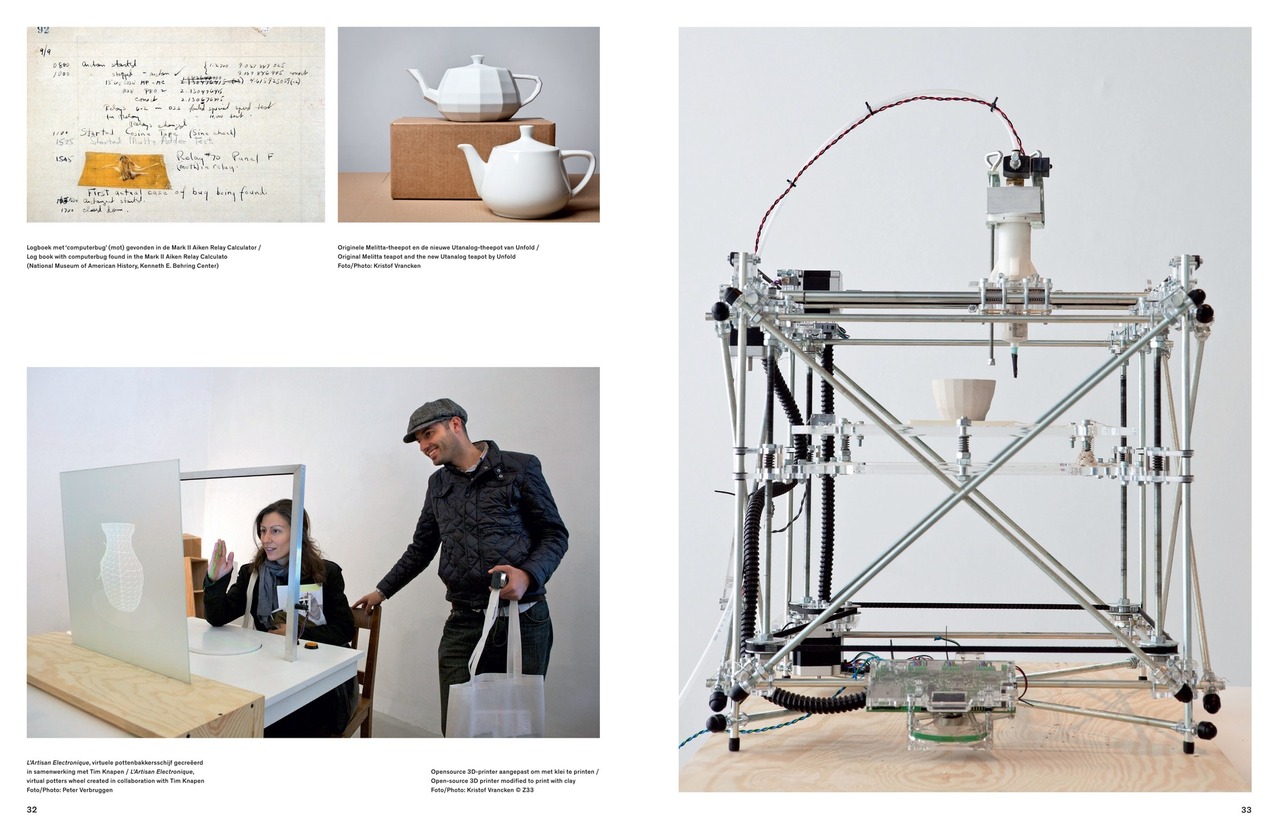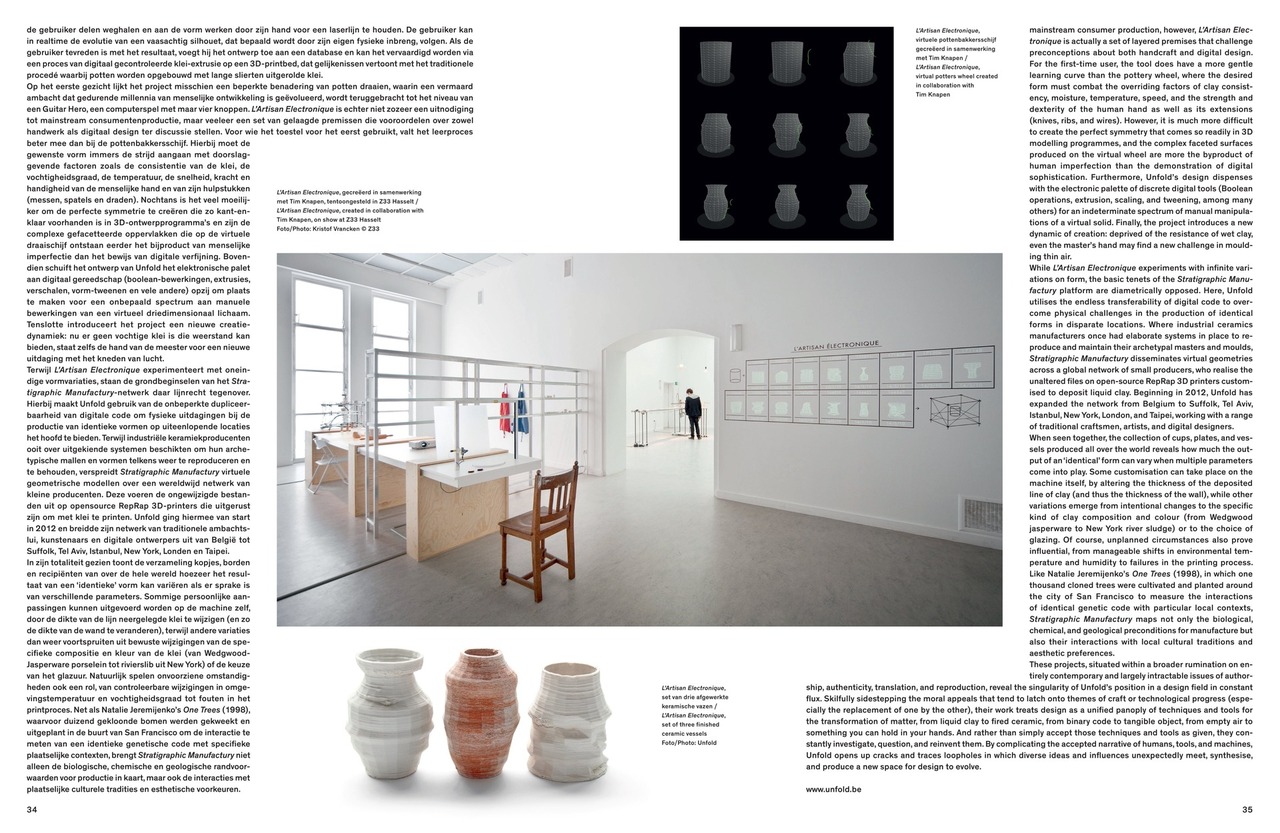January 2015, Unfold
won the
Henry
van de Velde Award for Young Talent.
Tamar Shafrir wrote an
excellent essay about Unfold for the catalogue accompanying the
exhibition at Bozar in Brussels. Click
More... to
read the whole essay or download here:
Reinventing
the Wheel (Dutch and English)
"Grace Murray Hopper, one of the first computer programmers at
Harvard University, used to tell the story of debugging the Mark II
Aiken Relay Calculator, an electromechanical computer. The problem
was traced to Relay #70 on Panel F, where the operators discovered
an intruder in the system. The event was duly recorded in the log
on 9 September 1947: “First actual case of bug being
found,” written below a moth taped to the paper.
The anecdote reveals something that has largely been forgotten as
digital technology became pervasive, microscopic, and black-boxed
beneath impenetrable glass and aluminium. The computer of 1947,
assembled at an architectural scale—18 metres in length, with
a 2.5-metre-high front panel—retained not only an
overwhelming sense of material physicality but also a sensitivity
to the capricious behaviours of its environment and the organic
bodies contained therein. Though the machine operated by different
logics, it was entirely ensconced within a natural system of chance
encounters, sparks, fumbles, and the odd winged creature.
Design itself has struggled with this precarious membrane between
the analogue and digital realms, although its initial confrontation
with that frontier is difficult to locate precisely. The onset of
industrial production, for example, could be considered the first
step towards a reproducible script, oblivious to the individual
authorship of the various figures involved in its manufacture, but
it might equally be seen as a mere progression of the repetitive
motor skills of the disciplined craftsman. The 1960s and ‘70s
breakthroughs in 3D modelling, from the wire-frame Boeing man to
real-time drawing in a graphic interface, tread a similarly
equivocal line between mathematical representation and design.
Still, as in the moth, the shift into the digital realm produced
several conclusive artefacts that can be used to mark its
borders.
One case is the Utah teapot, a virtual geometry created in 1975 by
Martin Newell to explore the basic problems of 3D modelling and
rendering. Based on a Melitta teapot, the original Utah was
shorter, due to the use of non-square pixels, and lacked a bottom,
since it would not be viewed from below. In 2009, the Belgian
design studio Unfold recreated this design as a working teapot,
cast in white porcelain from a 3D-printed mould. The Utanalog is an
iconic anachronism, transposing the faceted surfaces used on the
computer to ease the burden of graphic resolution into the real
world, where the smooth curves of the archetypal teapot are both an
outcome of the rotational geometry of the pottery wheel and a
functional asset for liquid-bearing vessels.
As the founders of Unfold, Claire Warnier and Dries Verbruggen have
continuously orchestrated these kinds of conversations between the
fields of physical making and digital form-giving. As ad-hoc
interpreters who speak neither the mother-tongue of computer code
nor that of traditional craft, they create unusual scenarios of
confrontation between the two in which the untranslatable, the
idiomatic and the unexpected are foregrounded against a field of
normative design practice. At the same time, each of their projects
also explores one of myriad tangents of the digital-analogue
divide, building a line of inquiry into issues such as technical
proficiency, intellectual property, and the uniqueness of the
identical object.
L’Artisan Electronique (2010), for instance, questions what
obstacles lie between skilled production and the casual user, as
well as the implications of the digitalisation of physical tools.
As a virtual cylinder spins on a computer screen, the user cuts
away and elaborates its shape by passing his or her hand through a
laser. The user can then see the live evolution of a vase-like
silhouette determined by their physical input. When satisfied, he
or she adds the design to an archive of shapes, which can then be
fabricated through a process of digitally-controlled clay
deposition on a printer bed, not unlike the traditional process of
building pots with long coils of rolled-out clay.
On first glance, the project might seem a reductive approach to
wheel-throwing, bringing an illustrious craft that has evolved over
millennia of human development to the level of a four-button Guitar
Hero. Rather than a proposal for mainstream consumer production,
however, L’Artisan Electronique is actually a set of layered
premises that challenge preconceptions about both handcraft and
digital design. For the first-time user, the tool does have a more
gentle learning curve than the pottery wheel, where the desired
form must combat the overriding factors of clay consistency,
moisture, temperature, speed, and the strength and dexterity of the
human hand as well as its extensions (knives, ribs, and wires).
However, it is much more difficult to create the perfect symmetry
that comes so readily in 3D modelling programmes, and the complex
faceted surfaces produced on the virtual wheel are more the
byproduct of human imperfection than the demonstration of digital
sophistication. Furthermore, Unfold’s design dispenses with
the electronic palette of discrete digital tools (Boolean
operations, extrusion, scaling, and tweening, among many others)
for an indeterminate spectrum of manual manipulations of a virtual
solid. Finally, the project introduces a new dynamic of creation:
deprived of the resistance of wet clay, even the master’s
hand may find a new challenge in moulding thin air.
While L’Artisan Electronique experiments with infinite
variations on form, the basic tenets of the Stratigraphic
Manufactury platform are diametrically opposed. Here, Unfold
utilises the endless transferability of digital code to overcome
physical challenges in the production of identical forms in
disparate locations. Where industrial ceramics manufacturers once
had elaborate systems in place to reproduce and maintain their
archetypal masters and moulds, Stratigraphic Manufactury
disseminates virtual geometries across a global network of small
producers, who realise the unaltered files on open-source RepRap 3D
printers customised to deposit liquid clay. Beginning in 2012,
Unfold has expanded the network from Belgium to Suffolk, Tel Aviv,
Istanbul, New York, London, and Taipei, working with a range of
traditional craftsmen, artists, and digital designers.
When seen together, the collection of cups, plates, and vessels
produced all over the world reveals how much the output of an
“identical” form can vary when multiple parameters come
into play. Some customisation can take place on the machine itself,
by altering the thickness of the deposited line of clay (and thus
the thickness of the wall), while other variations emerge from
intentional changes to the specific kind of clay composition and
colour (from Wedgwood jasperware to New York river sludge) or to
the choice of glazing. Of course, unplanned circumstances also
prove influential, from manageable shifts in environmental
temperature and humidity to failures in the printing process. Like
Natalie Jeremijenko’s One Trees (1998), in which one thousand
cloned trees were cultivated and planted around the city of San
Francisco to measure the interactions of identical genetic code
with particular local contexts, Stratigraphic Manufactury maps not
only the biological, chemical, and geological preconditions for
manufacture but also their interactions with local cultural
traditions and aesthetic preferences.
These projects, situated within a broader rumination on entirely
contemporary and largely intractable issues of authorship,
authenticity, translation, and reproduction, reveal the singularity
of Unfold’s position in a design field in constant flux.
Skilfully sidestepping the moral appeals that tend to latch onto
themes of craft or technological progress (especially the
replacement of one by the other), their work treats design as a
unified panoply of techniques and tools for the transformation of
matter, from liquid clay to fired ceramic, from binary code to
tangible object, from empty air to something you can hold in your
hands. And rather than simply accept those techniques and tools as
given, they constantly investigate, question, and reinvent them. By
complicating the accepted narrative of humans, tools, and machines,
Unfold opens up cracks and traces loopholes in which diverse ideas
and influences unexpectedly meet, synthesise, and produce a new
space for design to evolve."
 contact
contact


